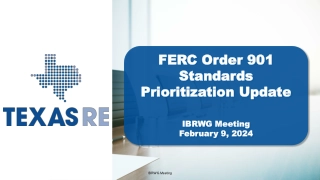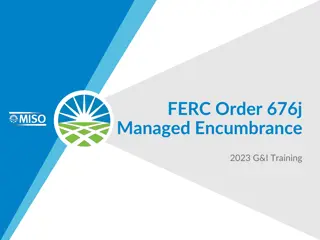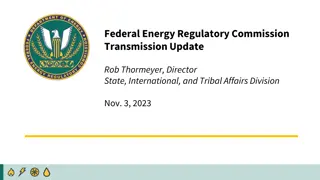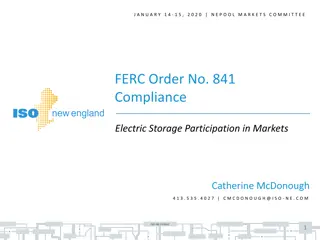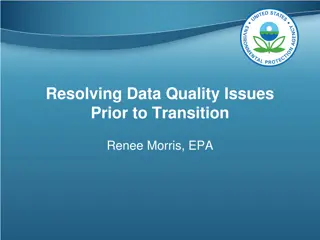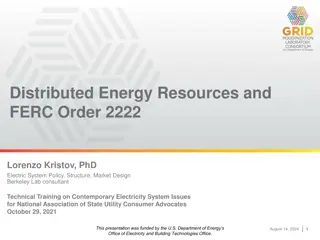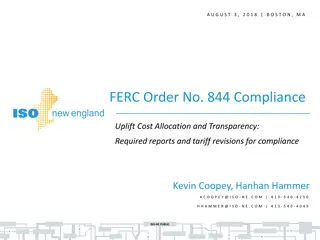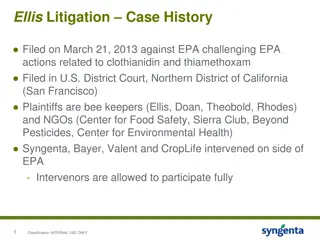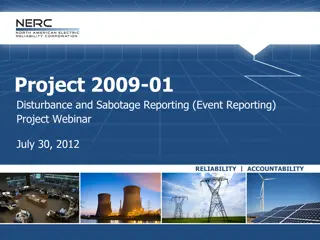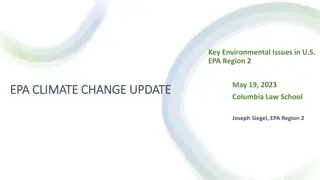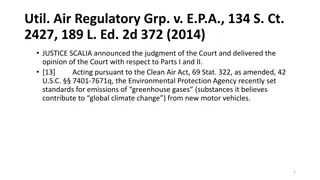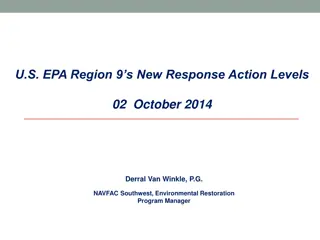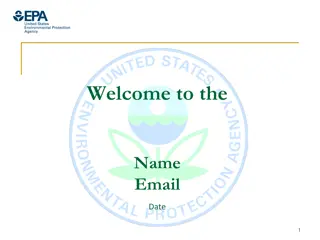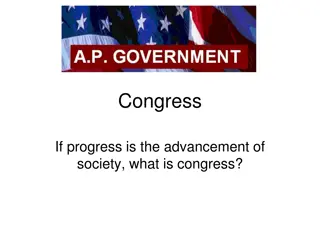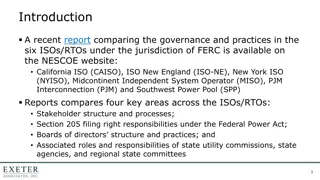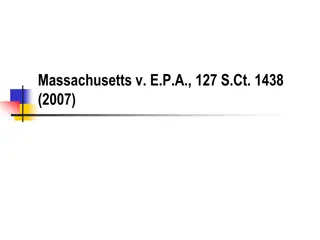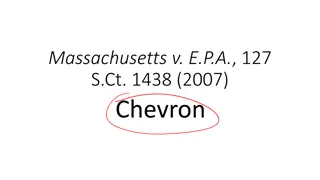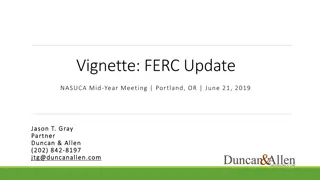Update on Washington FERC, EPA, and Congress Spring Agenda
Washington FERC, EPA, and Congress provide updates on legislative and regulatory agendas for the spring, including energy efficiency standards, greenhouse gas regulations, and cybersecurity protocols. APPA highlights priorities on distribution transformers, climate change, and grid security.
Download Presentation

Please find below an Image/Link to download the presentation.
The content on the website is provided AS IS for your information and personal use only. It may not be sold, licensed, or shared on other websites without obtaining consent from the author.If you encounter any issues during the download, it is possible that the publisher has removed the file from their server.
You are allowed to download the files provided on this website for personal or commercial use, subject to the condition that they are used lawfully. All files are the property of their respective owners.
The content on the website is provided AS IS for your information and personal use only. It may not be sold, licensed, or shared on other websites without obtaining consent from the author.
E N D
Presentation Transcript
An Update from Washington FERC, EPA, & Congress Desmarie Waterhouse Senior Vice President of Advocacy and Communications & General Counsel American Public Power Association MEPAV Annual Conference May 23, 2024 2 #PublicPower www.PublicPower.org
Whats on the Agenda This Spring Legislative: Fiscal Year 2025 appropriations bills National Defense Authorization Act Water Resources Development Act Oversight hearings on the Environmental Protection Agency s (EPA) final rules to regulate greenhouse gas (GHG) emissions from power plants 3 #PublicPower www.PublicPower.org
What Is on the Agenda This Spring Regulatory: Final rule by the Department of Energy (DOE) to improve the energy efficiency standards of distribution transformers released April 4 EPA final rules to regulate GHG emissions from power plants, mercury emissions, coal combustion residuals, and effluent limitation guidelines released April 25 Federal Energy Regulatory Commission (FERC) order on transmission planning (Order 1920) released May 13 Notice of proposed rulemaking (NOPR) on the Cybersecurity Incident Reporting for Critical Infrastructure Act of 2022 (CIRCIA) comments due July 3 4 #PublicPower www.PublicPower.org
APPA Priorities This Year Distribution transformers Implementation of elective pay Permitting reform/transmission Climate change Grid security 5 #PublicPower www.PublicPower.org
Distribution Transformers On April 4, DOE issued its final rule on energy efficiency standards for distribution transformers. It is a big improvement from the proposed rule under the final rule, the new efficiency standard can be met with only 25 percent of new transformers using energy efficient amorphous steel cores. The remaining 75 percent can continue to use grain oriented electric steel cores. Another improvement is that it extends the period for implementation from three years to five years. APPA is pleased DOE listened to industry and scaled back the final rule. We thank APPA members for their outreach to their elected officials over the last two years. 6 #PublicPower www.PublicPower.org
Distribution Transformers The House and Senate bills that were introduced earlier this year, along with the bipartisan letters from the House and Senate sent a clear signal to DOE on the impact the proposed rule would have the distribution transformer supply chain crisis. In late April, APPA and a coalition of electric utility, building, and manufacturing trade groups sent a letter to the leaders of the House and Senate Appropriations Committees thanking them for their efforts and noting the final rule is workable. It also noted that the final rule does not solve the shortage of distribution transformers that existed before the DOE s proposed rule, nor did it address the length lead times to procure products. As such, the coalition is requesting appropriations from Congress to help expand domestic manufacturing capacity for distribution transformers. 7 #PublicPower www.PublicPower.org
Distribution Transformers In addition to our efforts to secure appropriations to help manufacturers increase production, we are also continuing conversations with DOE and manufacturers through the Electricity Subsector Coordinating Council. We are also talking with APPA members on standardization efforts. 8 #PublicPower www.PublicPower.org
Elective Payment The Inflation Reduction Act (IRA) created the ability for public power utilities to directly claim tax credits for projects they own through elective payment. Elective pay of energy tax credits could be spur more generation ownership by public power utilities. It has been 21 months since enactment: Pre-filing registration of energy properties began in November 2023; The first tax filing season allowing for elective payment began in January 2024; and Final rules implementing the mechanics of elective pay were released in March 2024. While there have been some hickups in the pre-filing registration and tax filing process, the IRS and Treasury have been quite engaged to ensure that applicable entities get hands-on assistance when needed. 9 #PublicPower www.PublicPower.org
Elective Payment Unfortunately, key guidance, including relating to domestic content requirements for elective payment, has not yet been released. APPA has two key concerns: Obtaining the domestically manufactured products needed to meet the requirement will be quite challenging from a supply chain standpoint for years to come. Proving you have met the requirement, or qualify for one of the statutory exceptions, may be harder still. We consistently warn policy makers that a poorly designed regime could mean that otherwise viable projects die under the weight of red tape and uncertainty. 10 #PublicPower www.PublicPower.org
Elective Payment In December, Treasury and the IRS sought comments on statutory waivers to the domestic content requirements for elective pay. APPA drafted and organized a joint response from other stakeholders. We argued that domestic content rules should be simple, clear, and reliable. Changes to the IRA are unlikely to pass Congress in 2024, but we expect the legislation will be reviewed in 2025. APPA has begun looking at ways to improve the statute, including potential fixes to the domestic content requirements. APPA continues to educate on the Hill and in the Administration on the importance of getting elective payment implementation right. 11 #PublicPower www.PublicPower.org
Permitting Reform While there is bipartisan support for permitting reform to get energy infrastructure built more quickly, there is a partisan divide on what should be included in a bill. Republicans want changes to the Clean Water Act (CWA) and National Environmental Policy Act (NEPA) and Democrats want transmission policy reform. The prospects for comprehensive permitting reform legislation moving this year are low, but APPA continues to highlight public power s permitting reform priorities. CWA and NEPA reforms and other changes to speed up permitting for all kinds of energy infrastructure On the House side, Republicans are moving smaller bills to make changes to the CWA, NEPA, and Endangered Species Act. 12 #PublicPower www.PublicPower.org
Permitting Reform/Transmission Democrats are focused on transmission policy reform. They want FERC given primary siting and cost allocation authority over interstate transmission lines. They also want minimum transfer capabilities set between transmission regions. APPA has been advocating for broad permitting reform that applies to all electric infrastructure On cost allocation, we are very concerned about proposals that could lead to significant increases in transmission costs for public power utilities and their customers. We have encouraged policymakers to strive to build only needed new transmission at the lowest possible cost to consumers. 13 #PublicPower www.PublicPower.org
Permitting Reform/Transmission This is especially important as transmission is typically a fixed cost on customer bills, so this could be especially burdensome for low- or fixed-income families. Federal funding and incentives, including FERC s strengthened backstop siting authority under Federal Power Act section 216 (passed as part of the Infrastructure Investment and Jobs Act (IIJA)) and several DOE transmission funding programs, totaling over $5 billion from the IIJA and IRA, could help reduce these costs, but those savings must be passed on to customers. APPA also believes DOE could further encourage the development of needed transmission projects by prioritizing projects that include joint ownership opportunities for public power and other load-serving entities when selecting new transmission projects for federal funding or support. 14 #PublicPower www.PublicPower.org
Permitting Reform/Transmission While APPA maintains that permitting reform should be drafted in an infrastructure-neutral way to make it easier and cheaper to build all types of needed infrastructure, permitting reform and transmission policies remain intertwined in Congress. FERC s Order 1920 has amplified some of the partisan disagreements around transmission planning and cost allocation policies and has made the chance that a bipartisan compromise can be struck in 2024 very slim. Senate Majority Leader Chuck Schumer (D-NY) has declared permitting reform all but dead dead for the year. 15 #PublicPower www.PublicPower.org
Transmission On the regulatory side, FERC approved its final rule on May 13 on regional transmission planning and cost allocation and a separate rule on its ability to issue a permit if a state has denied an applicant s request to site transmission facilities in a National Corridor. From APPA s perspective, Order 1920 was a big missed opportunity, with FERC declining to adopt most of the cost containment mechanisms, allowances for regional flexibility, and opportunities for public power participation that APPA advocated for. The following slides provide APPA s initial analysis of the order. 16 #PublicPower www.PublicPower.org
Transmission Each region is required to conduct a long-term regional transmission plan at least once every five years that plans for transmission at least 20 years into the future. Context this is really the core innovation of the order. Reaction how this works will come down to the details in each region and how FERC views the compliance filing. Transmission providers must file a cost allocation methodology for long-term regional facilities, in consultation with state entities (does not include other stakeholders). Context FERC controversially declined to require state consent to the proposed cost allocation. All stakeholders can comment publicly, but transmission providers have no duty to engage with those comments. Reaction eliminating state vetoes is good. Excluding public power from the consultation process is bad. 17 #PublicPower www.PublicPower.org
Transmission Transmission operators must consider seven specific benefits for the selection of facilities and cost allocation. Avoided or deferred reliability transmission facilities and aging infrastructure replacement; Either reduced loss of load probability or reduced planning reserve margin; Production cost savings; Reduced transmission energy losses; Reduced congession due to transmission outages; Mitigation of extreme weather events and unexpected system conditions; Capacity cost benefits from reduced peak energy losses. Reaction it would have been better to allow for regional flexibility, but six of the seven benefits are generally quantifiable (mitigating extreme weather is trickier to quantify). 18 #PublicPower www.PublicPower.org
Transmission Transmission providers are required to reevaluate projects that were previously selected if the project faces delays, significant increased costs, or changes to federal/state laws. Context APPA had supported this as a common-sense cost containment measure. Reaction this is good. FERC did not adopt its proposed conditional right-of-first-refusal based on joint ownership. Context FERC said it will continue to consider this issue in further proceedings. Phillips and Clements both encouraged transmission providers to find ways to encourage joint ownership arrangements with load-serving entities in their footprint. Reaction it might be more legally durable to encourage joint ownership in a separate proceeding, but there is no guarantee that addressing it in a new proceeding will be a priority for the new commissioners. 19 #PublicPower www.PublicPower.org
Transmission FERC adopted a conditional right-of-first-refusal for right-sized facilities. Context this is intended to solve the problem that utilities would rather spend money on replacing old lines than building new ones. Reaction the final rule is an improvement over the proposed rule; whether it results in more efficient projects being selected remains to be seen. FERC is requiring enhanced transparency of local transmission planning inputs. Context several APPA members pushed hard for improving not only transparency but also engagement. PJM already has decent transparency, and it hasn t done much good for public power (i.e., stakeholder engagement). Reaction these changes will improve transparency in some regions but will fall short of creating meaningful stakeholder engagement. 20 #PublicPower www.PublicPower.org
Transmission FERC did not adopt its proposal to eliminate the incentive that allows utilities to recover construction work in progress (CWIP). Context CWIP allow utilities to start collecting money from ratepayers even before a project is used and useful (i.e., in service). Utilities like it because they don t need to use their own capital. Ratepayers bear more risk if the project is not ultimately built (i.e., don t get their money back). Reaction Anything that would have contained cost would be welcome (nothing to contain costs was included in final rule). FERC said it will look at incentives holistically in the future. 21 #PublicPower www.PublicPower.org
Interconnection FERC issued the Generator Interconnection Reform final rule (Order 2023) in July 2023 and largely reaffirmed it in Order 2023-A in April 2024. The reforms ordered by Order 2023 are intended to reduce the massive backlogs for projects seeking interconnection in RTO and non-RTO regions. At a high-level, Order 2023 requires all transmission owners to: Implement a first-ready, first-served cluster study process; Process interconnection requests faster than they currently do, with penalties for delays, and Modify the interconnection process to facilitate new technologies, like adding storage to an existing site. 22 #PublicPower www.PublicPower.org
Interconnection PJM submitted its compliance filing on May 16, 2024. At a high-level, PJM asserts that its existing interconnection process already complies with Order 2023. PJM reformed its interconnection process last year through an extensive Interconnection Process Reform Task Force that was generally supported by stakeholders. Order 2023, in PJM s view, mostly tells the rest of the country to do what PJM did. To the extent that PJM s existing processes differ from what is in Order 2023, PJM is asking FERC to allow for variations. 23 #PublicPower www.PublicPower.org
Interconnection At the end of 2023, there were over 286,000 MW of generation in PJM s queue (mostly solar and storage). PJM asserts that it is making significant progress on clearing its backlogged queue since implementing reforms last year. But timelines remain long. The first transition cycle kicked off in early January 2024 and is expected produce signed agreements in September 2025, after which permitting and construction can begin. 24 #PublicPower www.PublicPower.org
Climate Change On April 25, EPA released a package of rules to regulate emissions from power plants. This includes the regulation of GHG emissions from coal- and gas-fired power plants. Highlights of the final rule include: It no longer includes existing natural gas-fired power plants. It dropped the use of hydrogen co-firing as the best system of emissions reduction (BSER) for natural gas plants. Coal units planning to retire by 2032 and or that have a federally enforceable commitment to retire have no obligations except to retire. Coal units planning to operate past 2032 but to retire before January 1, 2039, have to co- fire with natural gas starting in 2030 BSER is 40 percent co-fire with natural gas. 25 #PublicPower www.PublicPower.org
Climate Change Coal units that will operate past January 1, 2039 the BSER is carbon capture and storage (CCS) operating at a 90 percent removal. New gas-fired combustion turbine (CT) baseload units must meet an 800lb/MMBtu emission rate. The limit for smaller units is on a sliding scale between 800-900 lb/MMTBu. These thresholds have some limited flexibility. Each state can provide a variance for individual pollution sources based on a series of factors, including the remaining useful life of the EGU. State plans are due 24 months after publication in the Federal Register. APPA and states have said three years is a more appropriate timeline for state plan development. 26 #PublicPower www.PublicPower.org
Climate Change It includes two reliability safety values: The first address situations where there is a true emergency, and the grid cannot supply reliable support. The second is when reliability authorities have identified problems with longer-term resource adequacy. In both cases, EPA is also providing a one-year extension for units that are planning to install control technology but are facing unanticipated delays. Of note, both PJM and SPP have criticized the rule and called out EPA s determination that CCS is BSER. Twenty-seven states and other stakeholders have challenged the final rules. The areas being challenged include: CCS as BSER The achievability of the performance standard 27 #PublicPower www.PublicPower.org
Climate Change Limiting the ability of states to set performance standards that are less stringent based on remaining useful life and other factors. Co-firing with natural gas this is redefining the source. EPA s reliance on tax credits to lower the costs of CCS and its underestimation of costs for CCS infrastructure. Reliability considerations The states and industry stakeholders are beginning to file stay motions. 28 #PublicPower www.PublicPower.org
Climate Change EPA has also opened a non-regulatory docket to get stakeholder feedback on how to regulate existing natural gas-fired power plants. This includes regulating air toxics and criteria pollutants, in addition to GHG emissions. APPA plans to file comments, which are due May 28. APPA participated in a roundtable discussion on the non-regulatory document earlier this month. If President Biden wins reelection, the proposed rules would likely be issued in 2025. 29 #PublicPower www.PublicPower.org
Climate Change There are efforts in Congress to overturn the GHG rule via the Congressional Review Act. House Republicans have begun holding oversight hearings on the final rule. Questions have also been asked in budget hearings of Energy Secretary Granholm and EPA Administrator Regan on the final rule. Last year, H.R. 6185, the GRID Act, was introduced and approved by the House Energy & Commerce Committee, to require FERC to review and comment on federal agency actions that are likely to have a significant, negative impact on the reliability and adequacy of the bulk power system. APPA supports the bill. 30 #PublicPower www.PublicPower.org
Grid Security CISA released its NOPR on implementation of CIRCIA in April. Comments are due July 3. The NOPR outlines: Who Must Report: Covered entities include electric utilities that are required to report cybersecurity incidents to the North American Electric Reliability Corporation (NERC) or DOE or that exceed the small business size threshold. What Cyber Incidents Trigger a Report: Any ransom payments plus all substantial occurrences that actually jeopardize, without lawful authority, an information technology (IT) or operational technology (OT) system. When Is the Report Due: No later than 72 hours after a cyber incident has occurred, and no later than 24 hours after a ransom payment has been made. 31 #PublicPower www.PublicPower.org
Grid Security What Must be Reported: Through a web-based form, a covered entity must provide information that includes a description of the covered incident, description of the vulnerabilities exploited, any available information about the identity of the perpetrator, and mitigation activities. Supplemental reporting is required as additional information becomes known. Avoiding Duplicative Reporting: CISA aims to avoid duplicative reporting by creating an exemption for covered entities that have a substantially similar reporting requirement to another federal agency if CISA has an information sharing agreement in place with that agency. We plan to urge CISA to: Exclude small electric utilities from the reporting obligation. 32 #PublicPower www.PublicPower.org
Grid Security Create a single point of reporting for the CISA, DOE, and NERC reporting obligations before making the CISA reports mandatory. Maintain the proposal to exclude attempted cyber attacks from the reporting obligation. Clarify that an entity s size is a factor in determining whether an incident is substantial (i.e., smaller entities should not have to report as many incidents as larger entities) Clarify that quick reporting should not interfere with mitigation and remediation, so initial reports (due within 24 or 72 hours) will contain only basic information with subsequent reports providing more details as they become available. 33 #PublicPower www.PublicPower.org
FERC Nominations FERC Commissioner Allison Clements term expires on June 30. While she can stay on until a replacement is confirmed, she has repeatedly declined to comment on her plans. Should she depart before a replacement is confirmed, FERC would be without a quorum. In February, President Biden nominated two Democrats, David Rosner and Judy Chang, and one Republican, Lindsay See, to be FERC commissioners. The Senate Energy & Natural Resources Committee held a confirmation hearing in March. Committee Chairman Joe Manchin (D-WV) is reportedly planning to hold a confirmation vote in June, which would clear the way for the nominees to be considered by the full Senate. 34 #PublicPower www.PublicPower.org
Sequestration of Direct Payment Bonds Direct payment bonds face two sequestration threats. There are ongoing 5.7 percent cuts to direct payment bond payments which began in 2013 as a result of the failure of the Joint Select Committee on Deficit Reduction. Those were set to expire after 2021 but have been extended repeatedly and now are set to last through 2033. Second, there is the looming threat of 100 percent cuts being triggered by the Pay-As- You-Go Act (PAYGO) due to Congress failure to offset the cost of the American Rescue Plan Act (ARPA). These cuts apply not only to direct payment bonds, but to elective payments tax credits. 35 #PublicPower www.PublicPower.org
Sequestration of Direct Payment Bonds Congress is unlikely to stop the 5.7 percent cuts early, i.e., before 2033, but for now appears to have dropped the habit of extending them every year or so. Congress has twice delayed but not waived the 100% PAYGO cuts (now set to begin after 2024). The severity of the cuts which would apply to almost all entitlement programs except Social Security mean they are unlikely to take effect. Some could see the threat as a useful hostage, meaning there could be drama before the threat is resolved. APPA is closely monitoring the PAYGO issue and stays in contact with fellow stakeholders and Budget Committee staff. 36 #PublicPower www.PublicPower.org


